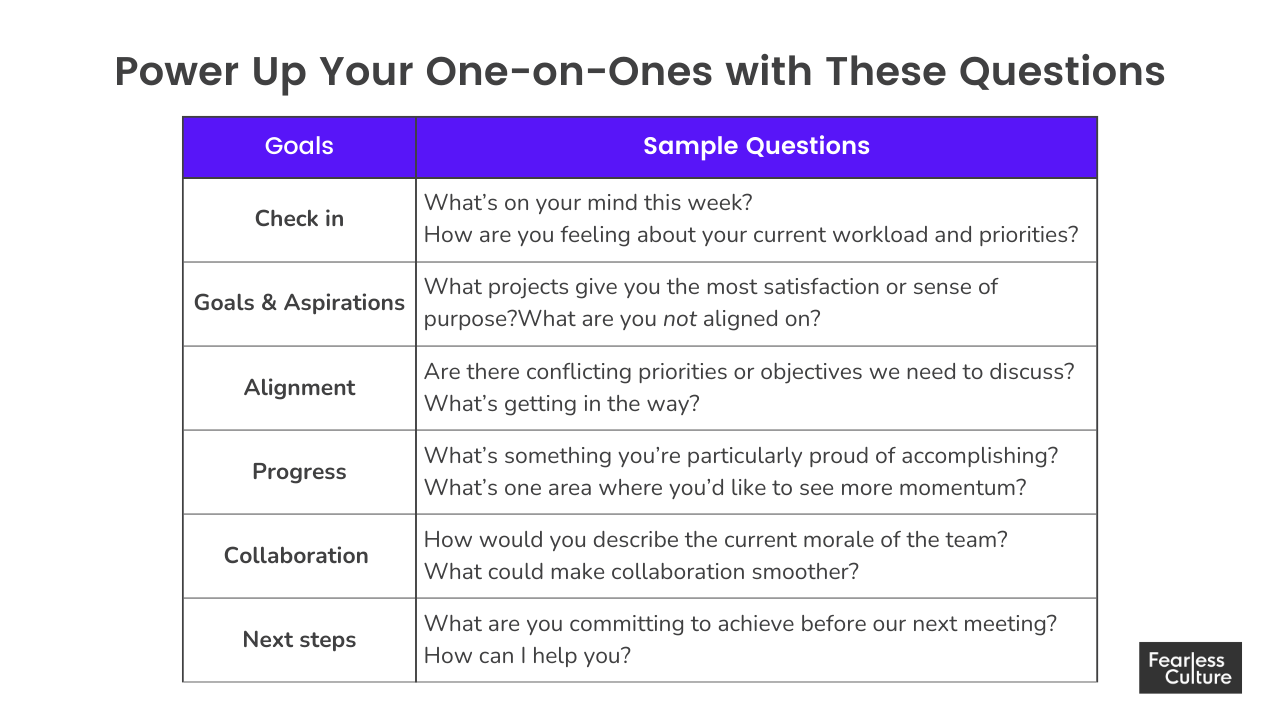This is How to Have One-on-One Meetings That Don’t Suck
A guide to making one-on-one meetings count: Meaningful conversations boost engagement, talent retention, and team collaboration.
One-on-ones have a bad reputation. Many view them as awkward or unproductive – just another meeting on an already packed agenda. Yet, they are critical to your team’s success.
When done right, one-on-one meetings can be game-changers for both leaders and team members. They provide a unique opportunity for genuine conversations. While email, Slack, or Zoom keep everyone in the loop, nothing replaces the value of direct, personal interactions.
However, great one-on-ones require more than just a quick check-in. They provide a chance to tackle bigger issues beyond regular updates.
Whether you’re looking to build trust, address roadblocks, or improve relationships, here’s how to transform your one-on-ones from a mundane task into a highlight of the workweek.
Key Benefits of One-on-One Meetings
Regular one-on-ones create a space for real connection and problem solving. They offer an opportunity to surface issues, promote dialogue between managers and employees, and focus on the big picture, providing perspective beyond day-to-day tasks.
A Gallup study revealed that employees who have regular one-on-one meetings with their managers are three times as likely to be engaged in their work. Here are some of the key benefits:
Get personal time
In a group setting, conversations can easily veer off track or get monopolized by a few voices. One-on-ones create a dedicated time to check in on specific progress, challenges, and needs – efficiently and directly. It’s a great way to identify bad habits before they become harmful.
Build trust
One-on-one meetings play a powerful role in improving personal relationships. Giving someone your full attention, even for 30 minutes, shows that you value them. This intimate environment provides a safe space to discuss career growth, performance challenges, or personal issues without the pressure of an audience.
Address roadblocks
One of the key responsibilities of a manager is to remove unnecessary roadblocks so people can focus on doing their work instead of fighting bureaucracy. Casual, frequent check-ins allow employees to raise things that are getting in their way rather than struggle alone in silence.
Encourage problem solving
When leaders encourage team members to voice challenges openly, they cultivate a culture where problems are surfaced early and tackled together. This approach helps address the root cause and not just the symptoms.
By inviting people to brainstorm solutions, managers become helpful partners rather than mere supervisors.
Keep remote workers connected
For remote or hybrid teams, regular check-ins are even more essential to increase a sense of belonging. Frequent one-on-ones help counter feelings of isolation, keeping team members engaged and aligned no matter where they’re working from.
Provide regular feedback
One-on-ones are perfect for giving timely, actionable feedback, allowing managers to address events soon after they happen. Because they are private and timely, providing constructive feedback feels less intimidating. In a safe environment, employees speak up more and can make [BM1] adjustments immediately rather than waiting for their annual performance review.
In short, one-on-ones aren’t just about tracking status; they’re about creating a foundation for trust, growth, and effective collaboration.
Design Effective One-on-One Meetings
Effective one-on-ones go beyond simply scheduling time on the calendar – they require intentional design. To make these meetings truly valuable, focus on the following key elements:
1. Establish ground rules
Whether you’re starting with one-on-ones or refining your approach, clarify your expectations and ground rules.
Explain the purpose of one-on-ones and how they will work, then address any questions from the team. Most importantly, emphasize that these are coaching sessions rather than reporting ones. The goal is not to control progress or micromanage people but to remove obstacles and support individual growth.
2. Reduce meeting anxiety
49% of team members feel anxious before one-on-one meetings with their manager – largely because they don’t know what to expect. To alleviate this, set clear expectations. Emphasize that it’s the employee’s time and meeting. Their needs, not hidden agendas, should drive the conversation. Additionally, defining the key theme or topic beforehand can significantly reduce anxiety.
3. Set a consistent rhythm
Research shows that employees who have regular one-on-ones feel less anxious and more successful in their roles. Ideally, meet with each of your direct reports once a week for 30 minutes. The second-best scenario is to meet every other week.
A regular cadence sets a rhythm that both you and your team members can count on.
4. Be flexible
Tailor each meeting’s purpose instead of sticking to a rigid agenda. One-on-ones aren’t one-size-fits-all, and each team member has unique needs and challenges that vary from week to week.
Some people may want to focus on career development, while others might need support solving specific challenges. Start each conversation by asking, “What’s the main topic you’d like to address today?”
5. Focus on outcomes
Avoid approaching the meeting with a rigid agenda or focusing solely on tasks. Questions like “Are you making progress with project Y?” might come across like a status report rather than a meaningful conversation.
Instead, discuss desired results and OKRs related to the project. One-on-ones should center on “How can we achieve the desired outcomes?” rather than simply reviewing milestones. This approach encourages a more strategic and impact-oriented conversation.
6. Make them optional
Schedule recurring one-on-ones but make them optional for employees. If your direct report feels they have nothing pressing to discuss in a particular week, allow them to skip the meeting. However, managers should never cancel these sessions, as it sends the wrong message.
Watch out for employees who regularly skip one-on-ones because they’re “putting out fires.” This could indicate they’re not prioritizing their own development.
Facilitate Meaningful One-on-One Conversations
The true value of one-on-ones lies in their execution. Consider the following tips to facilitate conversations that are meaningful and impactful:
Be fully present
This sounds simple, but it’s incredibly powerful. Close your laptop, silence your notifications, and give your team member your undivided attention. This signals that you’re actively listening, not just checking off another task.
Being fully present also lets you pick up on subtle cues and gain a deeper understanding.
Let them lead
Think of the one-on-one as their time, not yours. Encourage your team member to steer the conversation toward their key priorities. This could be project updates, current challenges, or personal matters affecting their work.
By encouraging them to take the lead, you create a space that’s truly theirs.
Listen, listen, listen
Research indicates that a key indicator of a successful one-on-one is the proportion of time the employee spends talking. Strive for them to speak for at least 50% of the time spent talking, preferably more.
Ask open-ended questions, let them elaborate, and resist the urge to jump in too quickly with solutions. This approach ensures they feel heard and encourages more open discussions.
Cover critical topics
To maximize the value of your one-on-ones, focus on six key areas: Personal Check-In, Goals and Aspirations, Alignment, Progress, Collaboration, and Next Steps. This framework helps both you and your team members prepare for meaningful conversations and concentrate on what’s most relevant at the time.
Consider this a flexible guide, not a rigid checklist. While Personal Check-In and Next Steps should bookend every one-on-one, other sections – like Goals and Aspirations or Progress – can be addressed as needed.
Use meaningful questions
Thoughtful, open-ended questions can turn a one-on-one from a routine check-in into a deeper conversation. Questions like, “What’s one area where you’d like to see more momentum?” or “If you could change one thing about your role, what would it be?” spark more meaningful conversations.
Rather than asking about updates or milestones, provoke reflection. Encourage your team member to think critically about their experiences, goals, and challenges.
Note: Find a comprehensive list of suggested questions for each topic at the end of the article (Appendix).
Follow up
A one-on-one doesn’t end when you leave the room (or Zoom call) – it’s just another step. Capture action items and follow-up agreements. Be sure to check in with team members before you next touch base.
Following through on what you discussed reinforces the value of one-on-ones and increases accountability. It shows that these conversations truly matter and have a real impact.
Intentional design and facilitation can transform one-on-ones into powerful conversations, making team members feel supported. Far from being just another routine meeting, they provide valuable opportunities to connect, align, and grow together.
By asking thoughtful questions, adapting to each team member’s unique needs, and using time wisely, one-on-ones become essential for building trust and accelerating collaboration.
Done well, they can evolve from a mandatory meeting into a highlight of the workweek.
Do you want to improve your meeting culture? Schedule a free consultation call to discuss how I can support you and your team.
[Appendix] Questions for Meaningful One-on-Ones
Consider these questions as prompts to explore meaningful topics rather than a script to follow. Adapt the conversation to your team member’s evolving priorities and unique challenges.
Personal Check-In
What’s something outside of work that makes you feel excited or energized?
Are there any challenges, personal or professional, that might be impacting your work right now?
What’s been on your mind this week?
Is there anything you’re worried about?
How are you feeling about your current workload and priorities?
Goals and Aspirations
What are your personal goals for this year?
What’s the most important thing you’d like to achieve within the next six months?
What skill or area would you love to develop to get there?
What projects or work gives you the most satisfaction or sense of purpose?
Where do you see yourself in the next year, and how can we work toward that?
Alignment
Are there any areas where our goals or priorities feel unclear?
Are you clear on how your role supports the team purpose?
Are there conflicting priorities or objectives we need to discuss?
What are you not aligned on?
Is there anything about our goals you’d like to discuss or clarify?
Progress
What’s something you’re particularly proud of accomplishing recently?
How do you feel about the progress you’re making with your goals?
Are there any roadblocks or setbacks we should address?
What’s one area where you’d like to see more momentum?
Is there anything you feel is slowing you down, and how can I help?
Collaboration
How would you describe the current morale of the team?
How are you feeling about your relationships with other team members?
Are there any areas of tension or conflict within the team that are affecting your work?
What could make collaboration smoother?
Which resources or changes could help improve team dynamics?
Next Steps
What are your top priorities before our next one-on-one?
What support or resources would help you achieve your current goals?
What are the key agreements from today’s meeting?
What’s one commitment you’d like to make before our next check-in?
How would you like me to follow up on what we discussed today?






Great post. You definitely need a structure and to let people know what will happen in the meeting.
Before starting one-to-ones it's also a good idea to tell the team what they are, why you're having them and what will happen. A form for the team member to complete is a great way to implement the structure.
Putting goals and KPIs (including training & career goals) at the end of the form keeps them front of mind too!
Thank you - valuable toolkit for anyone leading teams. A good system I found works is to alternate WIP meetings with one-on-ones on a fortnightly basis. WIPs are project update focused, one-on-ones are development focused and in-person, for hybrid team members, or FaceTime away from desks for fully remote team members. The change of setting signifies a change in purpose and meaning, and the fortnightly rhythm is enough time for people to take the developmental actions they have committed to. It helps to create a culture with a strong focus on learning.